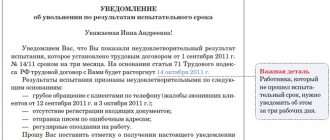Home / Labor Law / Dismissal and layoffs / Retrenchment
Back
Published: 05/09/2017
Reading time: 10 min
0
1456
Legislative consolidation of the staff reduction procedure is carried out by Part 2 of Art. 81 of the Labor Code of the Russian Federation, which deals with issues of dismissal at the initiative of the employer.
In addition to the need to comply with the established procedure for carrying out this procedure, the employer must also take into account the circle of subordinates and know who cannot be dismissed during staff reduction, as well as those who have a preferential right to retain their position. Therefore, it is worth considering in more detail the rights that are provided to employees when staffing is reduced.
- Dismissal procedure
- Fundamental rights of employees Receiving advance notice of dismissal
- Offering employees a different position
- Maintaining the order of dismissal
- Retention of position for certain categories of employees
- Receiving severance pay
- Receiving additional compensation in case of dismissal before the deadline
- Receiving salary for the second and third months after dismissal
- Employees who are not subject to dismissal
Dear readers! To solve your problem, call hotline 8 or ask a question on the website. It's free.
Ask a Question
Regulatory framework
The list of employee rights upon dismissal due to staff reduction is determined by two basic legislative acts. The first is the Labor Code of the Russian Federation, adopted on December 30, 2001 after the President of the country signed No. 197-FZ. It regulates relations between employees and employers in Russia. The federal law is regularly supplemented and adjusted, so the version dated April 24, 2020 is currently in effect. It takes into account the latest changes, including those related to the coronavirus pandemic.
The second important document is Federal Law No. 1032-1, dated April 19, 1991. It defines the basic principles of state policy in the field of employment of the country's population. Currently, the version of the Federal Law is in force, also adopted on April 24 of this year.
These regulations are supplemented by the provisions of numerous departmental documents adopted by various federal government agencies. Their number is constantly growing, especially rapidly recently, which makes this area of labor legislation one of the most complex.
Basic rights of an employee upon layoff
When answering the question of what rights are guaranteed to an employee upon redundancy, with some degree of convention they can be grouped into several categories. The most important ones are as follows:
- right to advance warning;
- offering alternative options;
- maintaining the order of priority when determining the list of dismissed employees;
- the presence of protected categories of employees;
- payment of compensation provided for dismissal due to reduction of compensation.
Each of the listed rights of an employee who was laid off due to staff reduction in 2020 requires more detailed consideration.
How to calculate two-week severance pay during layoffs
This payment is assigned when the basis for dismissal is not staff reduction or liquidation of the organization, but other reasons. However, the rules for calculating two-week severance pay remain the same.
The calculation algorithm corresponds to the principle of calculating the amount during reduction. First, the average income per working day is calculated. The resulting number is multiplied by the number of days.
There are the following grounds for calculating two-week severance pay:
- the employee refuses to move to a new position due to contraindications for health reasons;
- the company does not have conditions for the transfer of an employee;
- the employee is called up for military or alternative civilian service;
- a person refuses to move to a new job associated with the need to move to another locality;
- the employee who previously held the position of the resigning employee is reinstated in the workplace;
- a person terminates an employment contract due to a change in work responsibilities;
- dismissal for medical reasons.
Please note: the employer may establish in the local regulations of the organization additional conditions for calculating a two-week compensation and increasing its amount.
Information and timing of reduction
One of the basic rights of an employee is advance notice of the upcoming reduction and related dismissal. The period for mandatory notification of the employee is 2 months before the relevant decision is made. If we are talking about seasonal workers, they must be notified a week in advance.
Important . The specified two-month period is the minimum. It is allowed to provide information in advance, but no later than this date.
In addition to the employee, information about planned layoffs is communicated to the local department of the employment service and the trade union of the enterprise's employees, if one has been created. This is one of the employer's responsibilities. The deadlines for providing information established at the legislative level are as follows:
- when reducing less than fifty positions - 1 month;
- if you plan to fire from 50 to 200 people – 2 months;
- for larger reductions – at least 3 months.
List of rights, guarantees and compensations upon dismissal due to reduction in headcount or staffing
In Art. 178, 180 of the Labor Code of the Russian Federation and a number of other general norms of labor law determine what guarantees and compensations redundant employees can count on.
So, an employee who is laid off has the right to:
- Timely notification of the upcoming layoff (no later than 2 months before termination of the employment contract).
- Familiarization with the text of the layoff order, as well as information about the reasons for dismissal.
- An offer of another job or transfer to another position if there is a vacancy in the organization that matches his qualifications and state of health.
- Maintaining a job subject to high qualifications and labor productivity, as well as in the presence of disability, unemployed citizens in the family, dependents or the status of a veteran of the Great Patriotic War.
- Protection from reduction when assigned to one of the categories provided for in Art. 261 of the Labor Code of the Russian Federation (pregnant women, single fathers and mothers, mothers raising 3 or more children).
- Temporarily disabled citizens and persons on vacation also have protection from layoffs, BUT only until they return to work (Article 81 of the Labor Code of the Russian Federation).
- Severance pay is a benefit in the amount of monthly salary, taking into account incentive payments and bonuses, which is paid on the day of dismissal.
- Early termination of an employment contract and additional compensation upon dismissal by mutual agreement with the employer before the end of the notice period.
- Severance pay for the 2nd and 3rd month after dismissal, subject to lack of employment and registration with the employment center.
- Challenging administration decisions in court if the procedure for layoffs is violated.
- Taking paid leave if it is not used, or receiving monetary compensation for unused rest days.
Important! Minor workers can be laid off only after the consent of the labor inspectorate and the commission for minors (Article 269 of the Labor Code of the Russian Federation).
We also recommend reading:
Who shouldn't be laid off and who can?
What is better - reduction or dismissal by agreement of the parties?
What's the difference - downsizing or downsizing?
What should an employee do during such a procedure?
When an employee is presented with a fait accompli, and the layoff procedure is carried out in accordance with the law, it is quite difficult to change the management’s decision. In this case, the employee should take the following actions:
- Review a copy of the order and notice of the upcoming layoff, sign and date it.
- Start looking for another job and register with the employment center (within a week after dismissal).
- Comply with internal regulations and labor discipline.
- Submit a written statement to the employer if dismissal is necessary before the end of the notice period.
- Consider transferring to another position or require the employer to provide a list of vacant positions.
- Make sure that the employee is not included in the list of citizens who are not subject to reduction (Article 261 of the Labor Code of the Russian Federation).
- Check the notice periods, as well as compliance with the procedure for reducing the number and staff according to the law.
If the dismissal is contrary to the law or made with errors, it is necessary to send a written complaint to the manager with appropriate argumentation.
If the appeal remains unanswered or is refused, contact the labor inspectorate, and then the court.
What if the position is made redundant?
What to do if you are laid off? The reduction procedure may affect an employee not only due to a reduction in the number of staff, but also due to the abolition of his position.
The employer can also issue an order to reduce the number of positions in the organization. In this case, employees will be fired or transferred to another position.
When a position at work is reduced, employees have the same rights as when the number of staff is reduced. In particular:
- Management is required to send notice 2 months before dismissal or transfer (Part 2 of Article 74 of the Labor Code of the Russian Federation).
- Rights to severance pay, early dismissal, job retention and protection from layoffs are retained. This is due to the fact that if the transfer is refused, the employee will be dismissed due to reduction.
- Upon receipt of notification of a transfer to another position, the employee has the right to refuse or agree to the employer’s offer. Changing working conditions is permitted by mutual agreement of the parties (Article 72 of the Labor Code of the Russian Federation).
- The proposed position must correspond to the qualifications and health status of the person being laid off, but may be lower paid.
Offer an alternative position
Another important responsibility of the employer is to use all possible measures to maintain the employment of employees. One way to minimize layoffs in an organization and respect employee rights is to offer a transfer to another job. In this case, you need to follow three simple rules. Firstly, the proposed vacancy must correspond to the qualifications and physical characteristics of the employee.
Secondly, she can be on staff of any of the employer’s organizations. Thirdly, it is permissible to reduce the employee’s salary level. Despite the last point, such an employee’s right during layoffs at an enterprise should be considered extremely useful. Moreover, if we take into account the voluntary nature of the possible transition.
Sequence of dismissal
An equally important right of an employee when reducing jobs in an organization is the order of dismissal. The employer must keep more qualified employees employed. If we are talking about employees with equal levels of professional training, it is necessary to take into account the productivity of their previous work.
Significant legal nuance. For positions where documentary evidence of qualifications is not possible, the level of knowledge is determined by a specially created commission. It is recommended to include representatives of the trade union in its composition, which will ensure objectivity in decision-making.
Protected categories of employees
The legislation provides certain categories of workers with a preferential right to retain employment in the event of layoffs. Two criteria for their determination - qualifications and productivity - have already been announced. In addition to them, other things being equal, the employer, in the process of making a decision on dismissal, is obliged to keep the following categories of employees employed at the enterprise:
- with two or more dependents;
- the only worker in the family;
- who has become disabled or suffered an occupational disease/injury;
- war veteran;
- undergoing advanced training courses or other types of professional training at the expense of the employer.
The legislation allows for the provision of preferential rights to other categories of employees if this is provided for by the collective agreement in force at the enterprise. Some categories of employees cannot be dismissed due to reduction at all. These include:
- pregnant women;
- mothers raising a young child or a disabled child;
- mothers whose child is under 3 years old;
- sole breadwinners in the family;
- employees who are on vacation or sick leave.
Important . To dismiss a minor employee due to redundancy, it will be necessary to obtain the consent of the relevant commission and labor inspectorate.
Severance pay and additional compensation
If the company's workforce is reduced, the employee has the right to receive severance pay. Its value is the employee’s monthly salary. A seasonal worker is entitled to 2 weeks of earnings. The stated benefit amount is the minimum. The provisions of a collective or individual employment agreement may provide for more significant severance pay.
Another right of an employee dismissed due to job reduction is additional compensation while looking for a new job. It is paid in the amount of the employee’s average monthly earnings. Thus, the total payment amount is two monthly salaries.
Important .
In the event of a layoff at an enterprise, the employee retains all rights granted regardless of the reason for dismissal. These include payment of compensation for unused vacation during the year.
Dismissal procedure
An important condition for the legality of dismissal on such grounds as staff reduction is compliance with the established sequence of actions.
In general, this procedure looks like this:
- Issuance of a reduction order. It indicates which specific positions are excluded from the company’s staffing table, and also identifies the persons responsible for carrying out this procedure.
- Notification of the upcoming reduction of the trade union and employment authorities. Depending on the type of dismissal (regular or mass), the employer is given a set period of time to notify these authorities.
- Determination of categories of employees who cannot be dismissed and retain the right to continue working. The circle of these persons is determined both by federal legislation and by local acts of the enterprise.
- Notification of the upcoming procedure to employees. It is also carried out no later than the established deadline and exclusively in writing. The subordinate must confirm his familiarization with this information with a signature.
- Offer employees other vacant positions. The employer must notify employees of their presence throughout the entire layoff procedure - if one of them agrees, he will not be fired.
- Request for the opinion of the trade union body. This step is only required if the employee to be dismissed is a member of a trade union.
Official registration of termination of an employment contract. This stage consists of the following actions by the employer:
- issuance of a dismissal order (drawn up in the prescribed form and contains the basis for dismissal with reference to an article of the Labor Code of the Russian Federation);
- making an entry in the work book (also with reference to the relevant article of the Code);
- payment to the employee of all funds due to him.
The last two procedures are carried out on the employee’s last working day. As for payments, in addition to wages and vacation compensation, the employee is also entitled to severance pay. Read more about all employee rights below.
Actions in case of violation of employee rights
Any violations of the employee’s rights listed above upon dismissal due to staff reduction in the organization in 2020 become the basis for the employee to protect his interests. The standard procedure to take in such a situation is as follows:
- You should first contact the employer directly. Often, violations of the law are unintentional and can be corrected without the intervention of regulatory authorities. Moreover, any attempt to reach an agreement will be an important argument in favor of the employee in further proceedings;
- in the absence of a positive decision, it is necessary to send a complaint to the supervisory authorities. These include the labor inspectorate and the prosecutor's office. The appeal is formalized and must be registered in accordance with the procedure established by law;
- The last option to solve the problem is to file a claim in court. The case is considered by the authority at the place of registration of the employer.
It is possible to use all three methods simultaneously, but it is advisable to act in the specified sequence. The fact is that in most cases it is quite possible to achieve respect for the rights of an employee during staff reductions without going to the prosecutor's office, the labor inspectorate, and especially to the court. Employers know very well that any visit from supervisory authorities will most likely result in much greater financial losses than the payments provided for by law for employees upon dismissal. For assistance in resolving issues of unlawful dismissal, it is recommended that you contact the appropriate legal organizations.
What guarantees exist for subordinates?
The rights of a redundant employee are determined by his belonging to one or another category. If staff are reduced, not all employees will be able to get another vacancy.
Who can be offered another vacancy?
According to Part 1 of Article 180 of the Labor Code of the Russian Federation, if the number of subordinates is reduced or a department is abolished, the laid-off employees may be offered another position. However, according to the law (Article 179 of the Labor Code of the Russian Federation), first of all it is necessary to offer vacancies to people with higher qualifications and labor productivity compared to colleagues.
Important! The offered position may pay less than the previous one, but it must be suitable for the person according to his qualifications and state of health.
Note! In the era of coronavirus, everyone is looking for additional opportunities to earn money. It’s surprising that you can earn much more using alternative methods, up to millions of rubles a month. One of our best authors wrote an excellent article about making money on games with reviews from people.
Who will be transferred to part-time or part-time work?
In accordance with Article 74 of the Labor Code of the Russian Federation, a boss can introduce a part-time work shift for his subordinates if there is a threat of mass layoffs due to changes made to the organization’s staffing table.
For reference! In accordance with Resolution of the Council of Ministers of the Russian Federation dated 02/05/93 No. 99, dismissal will be massive if it is planned to lay off more than 50 people within 1 month.
The maximum period for which a part-time work shift can be introduced is six months. After the specified time has passed, the subordinate must be transferred to the previous mode of work.
Most often, the following groups of subordinates apply for part-time shifts:
- highly qualified people;
- subordinates who cannot be laid off (subject to certain circumstances).
The boss must notify employees of changes in the working day no later than 2 months in advance.
A person is free to refuse to work part-time. In this case, the day of termination of the employment contract will occur on the last date of the two-month notice about changing the duration of the shift, unless the subordinate leaves early.











